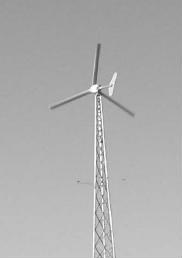Wind Turbines For Homes
This page will give you an idea on how you can use wind turbines or a hybrid home energy system to provide renewable electricity for your home.
Thinking of building a
Wind Turbine?
Click Here!
What Are Wind-Turbines?
Wind-turbines are basically machines designed to convert the energy of wind (kinetic energy) into mechanical energy and wind generators convert this mechanical energy into electricity.
The turbines are powered by the wind, a completely green renewable energy source, making wind turbines 'zero carbon' producing systems that do not contribute to the accelerating climate change.
What Size Turbine Do I Need?
The size of your turbine depends on the amount of electricity you want to generate. Residential turbines range from 400 watts to 100 kilowatts (KW); 100 KW is supplying a large load.
For example, a 1.5 KW turbine with an average wind speed of 6.2 meters per second (14 miles per hour) would meet the needs of a home requiring around 300 Kilowatt-hours (KWh) per month.
A typical home uses approximately 10,000 KWh of electricity per year which is about 830 KWh per month so it easy to see that a 100 KW turbine isn't really needed for domestic use. The average residential home wind turbine system is usually 5 KW or less.
What Type of Electrical Current Do Turbines Generate?
The current generated by small turbines that are used in homes is direct current (DC) which is not suited for home use.
Not to worry: as with photovoltaic (PV) systems, the direct current is converted to alternating current (AC) (suited for homes) by a current inverter which is then used directly in grid connected systems, or from batteries in off grid stand alone systems.
Incidentally wind turbines are substantially cheaper than a comparable photovoltaic system - if your home has access to good unobstructed wind flow.
What Are The System Components?
Basically a residential wind-turbine energy system comprises:
- A rotor
- A generator or an alternator mounted on a frame
- A tower
- Wiring and system components - controllers,inverters and/or batteries
With proper maintenance wind turbines can last as long as 20 years.
Note: the higher the tower the better the wind speeds (less air turbulence caused by obstructions such as buildings and trees) which means more power production.
Are There Different Types of Towers?
Yes. There are two basic types - the free standing self supporting tower and the guyed tower. The guyed towers are easier to install than the self supporting towers and are less expensive.
However, with the guyed tower you will need adequate space to install it as the radius for the supporting guy wires need to be 50 to 70% of the tower's height.
The self supporting tilt-down tower is more expensive than the guyed tower but the tilt-down feature allows for easier maintenance and the protection of the wind turbine in hazardous weather like hurricanes.
Most wind powered turbines have an automatic over-speed governing system that keeps the rotor from spinning out of control in very high winds.
Wind powered turbines offer you an affordable alternative way of providing your home energy needs that's both sustainable and cost effective.
What are Hybrid Systems?
A hybrid system is a combination of the wind and photovoltaic technologies. You can even add a diesel generator to a hybrid system that runs on biodiesel. An off grid hybrid system removes the possibility of intermittent power supply.
This is because in the summer period there is usually more sun and less wind, and in the transitional months of low sunlight the wind is generally stronger.
If you had a period of no or poor sunlight and no wind for battery charging, the generator could then be used to charge the batteries.
Are The Turbines Noisy?
Not really. On average the sound level of a residential wind turbine is around 55 decibels so if you really listen for it you will hear it, but no more than your normal home refrigerator.
See also:
Click here to visit online store.
Home Heat Loss Heat Gain Radiant Heat Central Heating Radiators UFH
Heat Pumps GSHP's WSHP's ASHP's Solar Heating PV Systems Boilers
Water Heaters Insulation Elec-Heaters
Terms of Use | Privacy | Contact Us

|
Visitors Say
Hi, My name is Shannon and I'm one of home-heating-systems-and-solutions.com readers. I'd like to thank you for the excellent information I've found on home-heating-systems-and-solutions.com, it's one of my favorite readings on the net. Warmest Regards Shannon United States
Thanks for the advice for removing an air lock from an indirect system. Had to change an inlet on my cistern. First time I have tried any home plumbing. After draining the cold tank system air locked when I refilled the tank. Garden hose and mains pressure up the tap sorted my problems. Would not have known what to do without the advice on the site. Many thanks Sean United Kingdom.
An excellent site. I have found it very usefull. I am currently in the design phase of a new house and have be pondering which heat system to use. From your site I have been able to choose the right system. Ross New Zealand
I enjoyed your site. Pat United States
We're so excited to announce our first Children Book
The Special and Talented Dog Show
To order click here
The second book published is called
Flying Things
This is aimed at a pre-school audience and is a rhyming story. You can buy by clicking here
To read more about our children's books, click here




